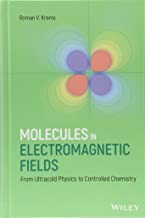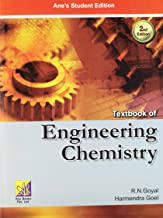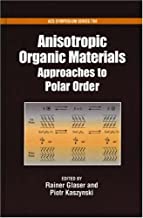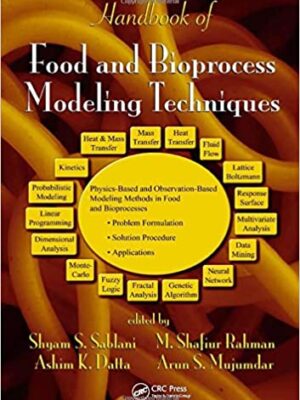Molecules in Electromagnetic Fields: From Ultracold Physics to Controlled Chemistry
Original price was: ₹11,190.14.₹8,952.11Current price is: ₹8,952.11.
ISBN: 9781118173619
Author/Editor: Roman V Krems
Publisher: John Wiley
Year: 2019
1 in stock (can be backordered)
Description
This book introduces the reader to the quantum theories needed to describe the interactions of diatomic molecules with electromagnetic fields and systematically discusses the effects of static and dynamic electric and magnetic fields on the rotational, fine, and hyperfine structure of molecules. It illustrates how the concepts developed in ultracold physics research have lead to what may be the beginning of controlled chemistry in the fully quantum regime. The theories described are applied to discuss examples from research on trapping molecules in electromagnetic fields, laser control of molecular rotations and external field control of microscopic intermolecular interactions. The book presents the description of scattering theory for molecules in electromagnetic fields and is written to be a practical guide for students working on various aspects of molecular interactions.
Additional information
| Weight | 0.722 kg |
|---|
Product Properties
| Year of Publication | 2019 |
|---|---|
| Table of Contents | List of Figures xiii List of Tables xxv Preface xxvii Acknowledgments xxxi 1 Introduction to Rotational, Fine, and Hyperfine Structure of Molecular Radicals 1 1.1 Why Molecules are Complex 1 1.2 Separation of Scales 3 1.2.1 Electronic Energy 5 1.2.2 Vibrational Energy 10 1.2.3 Rotational and Fine Structure 14 1.3 Rotation of a Molecule 17 1.4 Hund's Cases 21 1.4.1 Hund's Coupling Case (a) 21 1.4.2 Hund's Coupling Case (b) 22 1.4.3 Hund's Coupling Case (c) 23 1.5 Parity of Molecular States 23 1.6 General Notation for Molecular States 27 1.7 Hyperfine Structure of Molecules 28 1.7.1 Magnetic Interactions with Nuclei 28 1.7.2 Fermi Contact Interaction 29 1.7.3 Long-Range Magnetic Dipole Interaction 30 1.7.4 Electric Quadrupole Hyperfine Interaction 31 Exercises 31 2 DCStarkEffect 35 2.1 Electric Field Perturbations 35 2.2 Electric Dipole Moment 37 2.3 Linear and Quadratic Stark Shifts 40 2.4 Stark Shifts of Rotational Levels 42 2.4.1 Molecules in a 1Sigma Electronic State 42 2.4.2 Molecules in a 2Sigma Electronic State 46 2.4.3 Molecules in a 3Sigma Electronic State 48 2.4.4 Molecules in a 1Pi Electronic State - Lambda-Doubling 51 2.4.5 Molecules in a 2Pi Electronic State 54 Exercises 56 3 Zeeman Effect 59 3.1 The Electron Spin 59 3.1.1 The Dirac Equation 60 3.2 Zeeman Energy of a Moving Electron 63 3.3 Magnetic Dipole Moment 64 3.4 Zeeman Operator in the Molecule-Fixed Frame 66 3.5 Zeeman Shifts of Rotational Levels 67 3.5.1 Molecules in a 2Sigma State 67 3.5.2 Molecules in a 2Pi Electronic State 71 3.5.3 Isolated Sigma States 74 3.6 Nuclear Zeeman Effect 75 3.6.1 Zeeman Effect in a 1Sigma Molecule 76 Exercises 78 4 ACStarkEffect 81 4.1 Periodic Hamiltonians 82 4.2 The Floquet Theory 84 4.2.1 Floquet Matrix 88 4.2.2 Time Evolution Operator 89 4.2.3 Brief Summary of Floquet Theory Results 90 4.3 Two-Mode Floquet Theory 92 4.4 RotatingWave Approximation 94 4.5 Dynamic Dipole Polarizability 96 4.5.1 Polarizability Tensor 97 4.5.2 Dipole Polarizability of a DiatomicMolecule 99 4.5.3 Rotational vs Vibrational vs Electronic Polarizability 101 4.6 Molecules in an Off-Resonant Laser Field 104 4.7 Molecules in a Microwave Field 107 4.8 Molecules in a Quantized Field 109 4.8.1 Field Quantization 109 4.8.2 Interaction of Molecules with Quantized Field 116 4.8.3 Quantized Field vs Floquet Theory 117 Exercises 118 5 Molecular Rotations Under Control 121 5.1 Orientation and Alignment 122 5.1.1 OrientingMolecular Axis in Laboratory Frame 123 5.1.2 Quantum Pendulum 126 5.1.3 Pendular States of Molecules 129 5.1.4 Alignment of Molecules by Intense Laser Fields 131 5.2 Molecular Centrifuge 136 5.3 OrientingMolecules Matters -Which Side Chemistry 140 5.4 Conclusion 142 Exercises 142 6 External Field Traps 145 6.1 Deflection and Focusing of Molecular Beams 146 6.2 Electric (and Magnetic) Slowing of Molecular Beams 151 6.3 Earnshaw'sTheorem 155 6.4 Electric Traps 158 6.5 Magnetic Traps 162 6.6 Optical Dipole Trap 165 6.7 Microwave Trap 167 6.8 Optical Lattices 168 6.9 Some Applications of External Field Traps 171 Exercises 173 7 Molecules in Superimposed Fields 175 7.1 Effects of Combined DC Electric andMagnetic Fields 175 7.1.1 Linear Stark Effect at Low Fields 175 7.1.2 Imaging of Radio-Frequency Fields 178 7.2 Effects of Combined DC and AC Electric Fields 181 7.2.1 Enhancement of Orientation by Laser Fields 181 7.2.2 Tug ofWar Between DC and Microwave Fields 182 8 Molecular Collisions in External Fields 187 8.1 Coupled-ChannelTheory of Molecular Collisions 188 8.1.1 A Very General Formulation 188 8.1.2 Boundary Conditions 191 8.1.3 Scattering Amplitude 194 8.1.4 Scattering Cross Section 197 8.1.5 Scattering of Identical Molecules 200 8.1.6 Numerical |
| Author | Roman V Krems |
| ISBN/ISSN | 9781118173619 |
| Binding | Hardback |
| Edition | 1 |
| Publisher | John Wiley |
You must be logged in to post a review.






Reviews
There are no reviews yet.